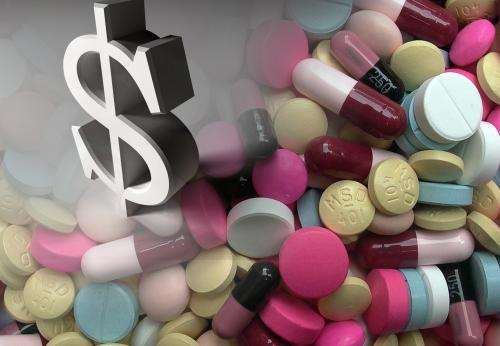Medication spending may rise five percent this year

(Medical Xpress)—Total spending on prescription medications has been declining for several years, but that trend is expected to reverse and rise 3 to 5 percent for 2014, according to a new report by a team led by the University of Illinois at Chicago's Center for Pharmacoepidemiology and Pharmacoeconomic Research.
The report reviews recent changes in drug costs; identifies factors likely to influence future prescription expenditures; and projects drug spending for this year.
It will be published in the March 15 edition of the American Journal of Health-System Pharmacy.
"While prescription drugs are considered to be increasingly expensive, the overall rate of increase in drug expenditures has generally declined over the past 15 years," says lead author Glen Schumock, professor and head of pharmacy systems, outcomes and policy at the UIC College of Pharmacy.
For the first nine months of 2013, he said, it was a record low 0.4 percent.
Several factors contributed to the decrease, Schumock said. The U.S. economic downturn, increased use of generics, and efforts to curb costs under the new health care reform plan all played a role.
But costs may rise again this year, he said, because of increased access to pharmaceuticals with the expanded insurance coverage under the Affordable Care Act.
According to the Congressional Budget Office, 14 million previously uninsured Americans are expected to gain coverage in 2014 either through Medicaid expansion or the insurance exchanges. As a result, U.S. health care expenditures may rise up to 6.1 percent, reaching $3.09 trillion, or 18.3 percent of gross domestic product.
Prescription drugs account for about 11 percent of overall U.S. health care expenditures, Schumock said. The 3 percent to 5 percent increase in overall drug expenditures the report forecasts includes a 5 percent to 7 percent rise in spending for clinic-administered drugs and a 1 percent to 3 percent increase in hospital drug expenditures.
Total prescription sales for the 12 months ended last September were about $326 billion, 0.7 percent lower than sales during the previous 12 months, Schumock said.
Clinics and nonfederal hospitals saw increased drug spending (4.5 percent and 1.8 percent growth, respectively) in 2013 relative to 2012, Schumock said. Federal facilities showed decreased expenditures (-13.7 percent), as did the long-term care (-4.2 percent), mail order (-1.9 percent) and retail pharmacy (-0.3 percent) sectors.
There is also a trend toward using drugs that are increasingly complex, which are more expensive than traditional phamaceuticals, Schumock said.
"This year a company announced that its new hepatitis C therapy will cost $1,000 per day, or $84,000 for a typical course of therapy," he said. "A significant amount of effort will be needed to ensure that these drugs are used appropriately. This is a great opportunity for pharmacists who have knowledge in both the clinical and economic factors that need to be considered."
Publication of the forecast is eagerly awaited each year by hospital and health-system pharmacists who use it to help project drug spending and develop budgets at their own institutions, Schumock said.
















